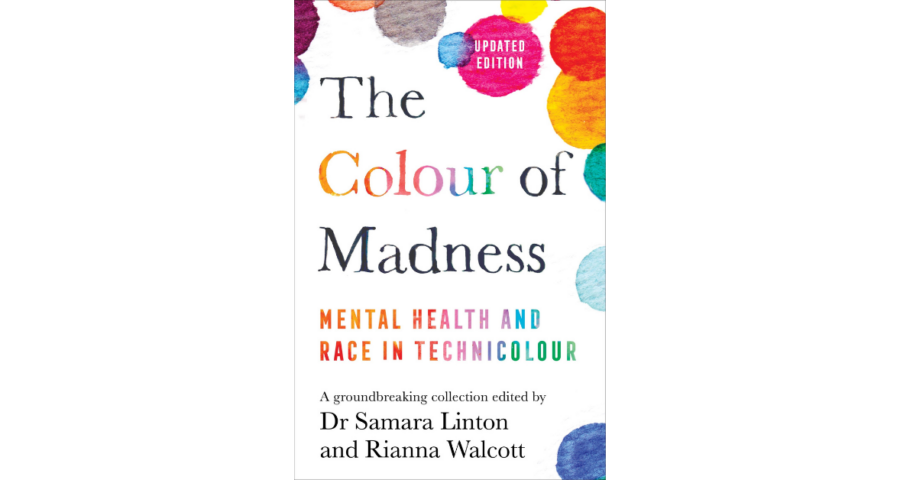The Colour of Madness features creative prose, essays, fiction, poems, and artwork about mental health by almost 100 contributors. It is a second edition and is rightly referred to as ‘groundbreaking.’
We start with the ‘Red’ chapter, representing rage and defiance, and move across the colour spectrum, ending with ‘Violet.’ Some contributions are now in other sections or reconfigured, and the meaning behind the colours is explained in detail, so this time around, the placement of each piece makes more sense. There is new content, as well as a different cover and the addition of an index. Although ‘BAME’ was used in the original title, the updated version references ‘Race’ instead. This feels fitting, given recent tussles over the usefulness of the racial descriptor ‘BAME.’ Numerous topics are covered – insomnia, ableism, cooking, homelessness, and alcoholism. The editors were committed to localising the edition, focussing on a UK context. This is appreciated when so many books at the intersection of race and mental health come from an American perspective.
Rianna Walcott refers to this ‘refinement’ as ’bittersweet’ (p. 1). They overcame struggles that uncomfortably mirror the dynamics of racial domination endemic to the UK – their first publisher was a secret White Supremacist. Sadly, some contributors from the first edition are missing, which is understandable given those events. As grateful as I am for this book, I’m also frustrated that the editors had to produce their first edition under duress, lacking the support their work deserved. They completed it with an elegance and resolve they shouldn’t have needed. It was a fight to get their flowers, and many writers featured in the book have clearly experienced something similar.
The deliberately interdisciplinary nature of The Colour of Madness breaks down distinctions between service user and provider, marginalised patient, and medical gatekeeper. There are a range of formats that aren’t usually ‘allowed’ by publishing or academia to exist side by side if they are to be taken ‘seriously’, making this anthology a breath of fresh air. Society must critique information gathering hierarchies and acknowledge wisdom presented through other means, by and for us, as ‘unpicking knowledge and power in mental health’ suggests. The Eurocentric, Enlightenment idea that the most reliable methodologies are rational, objective, and emotion-free is flawed; evidence-making processes are never ‘power neutral’ (p. 213).
I enjoy the fact that contributors chose their own words to describe their conditions and those of their loved ones (or not, if they didn’t wish to be labelled). Medical language is usually impenetrable; patients are alienated from their diagnoses and the workings of psychiatry. This book lets writers reinvent and own their experiences. They include cultural references. They imagine psychosis as a universal mystery, not tragic. Delusions are a metaphor; hallucinations offer symbolic guidance.
Points are made about stigma based on religion and culture – it’s tougher to divulge that you are overwhelmed if you fear being ostracised. Elders who take pride in diasporic resistance tell us to overcome, to be grateful, to endure. Our strength as minoritised collectives leads to tough love as a coping strategy. We soldier on and provide unpaid labour, afraid to admit we can’t cope; eventually people pay the price mentally. Further, the book touches on the idea that our parents might feel ashamed of our illnesses, blaming themselves for having an unwell child (‘your only daughter has chosen sickness over health’) (p. 62). Some illnesses are seen as for Oyinbos, for white people. Does that mean you are not as African for suffering? Should you feel like a coconut if you self-harm?
The poem ‘Lost’ encapsulates aspects of being a child of the diaspora that aren’t taken into account by mainstream services: ‘I have lost my mother tongue…I have lost a nation and how to say my name’ (p. 38). Feelings of incomprehension, of being unable to access parts of your culture or fulfil certain role expectations, mean that preserving traditions can be restrictive and exhausting, although productive and nourishing too. ‘Lost’ ends with a defiant note about biting the hand that feeds, maintaining a mood of reclamation.
‘The Stigma of Suicide’ advocates for integrating religion into care, if appropriate. A detached, secular stance is often taken, with spirituality stripped of its soul and fed back to us in sterile, commodified form. The narratives of our ancestors speak of intergenerational trauma passed down through our DNA, yes, but also of restorative ancestral and spiritual practices. We are called to ‘excavate…ancestral memory’ (p. 178) and tap into this inheritance in ‘Animal Print and Headwrap’. However, religious intervention can be harmful – in ‘Depression, Doubt, and Deliverance’, there is the Pentecostal and Evangelical belief that faith healing can replace counselling. Depression might be attributed to demonic possession.
The artwork in the middle of the book expresses despair, solidarity, loneliness, and acceptance, through vulnerable self-portraits in broad strokes. The sculptures in ‘We Rise’ subvert classist European artistic norms, reclaiming lost personhoods and disrupting caricatured likenesses by lovingly celebrating and exaggerating Black features. In the postscript for ‘Magaj’, the artist refers to people in the South Asian community who clothe themselves in materialistic illusions to fit in, adopting a ‘rich white women aesthetic’ out of a ’toxic love’ of status (p. 167). Of course, this is unsustainable, resulting in a crisis of identity, and the eventual realisation that the ’Eurocentric linear narrative formula’ (p. 177) can’t explain the full scale of their existence.
In the subsequent ‘Blue’ section, a support worker asks ’Am I helping?…I didn’t sign up for this’ (p. 207) as she grapples uncomfortably with the realities of restraining someone to medicate them. Is joining the system the best way to change it? One contributor mentions that ’paranoid’ (p. 193) recollections of racism go unacknowledged by other therapists – after all, to the typical white, middle-class practitioner, there is merit in remaining ‘neutral’ and ’colourblind’ (p. 194). This section highlights the reality that on many wards, there are no BAME permanent staff, only agency workers. Recruitment practices need to be looked at to diversify the psychotherapy field. The author of ‘Ramblings of the Scarred’ reflects on their time training to be a counsellor and psychologist, where they were told ‘it is not about us’ (p. 43). She feared sharing her account initially, but ’practitioners…reinforce power dynamics where we are peddled as ”expert” without being able to relay the “journey” of “our own human experience”’ (p. 44).
Psychology as a discipline takes an individualistic approach. Healthcare professionals can fail to understand that inhabiting a hostile social location as a marginalised person has a direct impact on mental health, and intersecting external factors complicate recovery – things like being discriminated against for your sexual orientation or being detained. In ’He Was Treated Like a Criminal,’ LGBTI+ refugees experience criminalisation and distress. A study of people seeking asylum (Keller et. al, 2003) found 86% had Depression, and 50% had PTSD symptoms. Economics affects wellbeing too; if you are “’’too sick to work but too broke to be sick’ (p. 112) you can’t ‘self-care’ your way out of poverty. The book addresses the ignorance behind the idea that ’the patient’s culture has no bearing on the treatment’ (p. 286) – in fact, mental health is inextricably linked to the conditions of our lives.
’God Forbid’ sends the message that non-white people are constantly traumatised by caregivers who may see them as less than, a radical Muslim, strange, too much, not ‘one of us’. Seeking help from this inhospitable system becomes a terrifying option. In ‘The Long Goodbye’, the assumptions made by a nurse, who mistakenly directs a Black family to the Pentecostal church when they arrive at an eating disorder unit, suggests a perception that they do not belong. Do the people treating us see us for who we are? Or as stereotype? Biases and prejudices can have devastating, real-world consequences for treatment outcomes. According to NHS figures, in 2017-18 Black/Black British people were four times likelier to be detained under the Mental Health Act than white people. There are higher incidences of serious conditions that have worsened without early intervention. Black women also have the highest rates of common mental disorders like anxiety and depression (Linton, no date), all while being called difficult by doctors and facing walls of indifference.
People somatically marked as other struggle to escape racism, even when dealing with peers. In ‘Highlights’, anger towards another racist patient is deemed ’inappropriate’ – ’She’s unwell, don’t mind her’ (p. 62). The protagonist is forced to absorb abuse for everyone else’s sake. Then there’s the sting of a wire golliwog sculpture being praised unreservedly by an art teacher, and the bewilderment when they do not ’intervene and protect’ their Black student (p. 181). Or being referred to the Prevent programme after being misheard during a stay at a psychiatric ward because of your beard and skin colour. Being othered like this is exhausting, and the somatic repercussions lead to health disparity.
In an interview with Media Diversified, Walcott stated a desire for the book to make an impression on funding bodies and policy makers, as well as people in community spaces. And they have achieved that, showcasing a need for more work like this. The book has since featured in NHS libraries and on university syllabi, been placed on NHS mental health wards, and the editors have worked closely with organisations that improve mental health research or access to support.
Despite the heavy subject matter, the book hinges on a sense of hope, and as I read this, I felt called into something private and comforting. Art is an emotive and nuanced language that is widely understood, with the power to advocate for change. Whether this book lands in the hands of practitioners or public library users, this thought-provoking volume might plant a wilful seed of dissent or create a thirst for transformation. Above all, The Colour of Madness wants the unheard to prioritise open discussions, authenticity, getting connected, and resting.
References:
Keller, A.S., Rosenfeld, B., Trinh-Shvrin, C., Meserve, C., Sachs, E., Leviss, J., Singer, E., Smith, H., Wilkinson, J., Kim, G., Allden, K., & Ford, D. (2003). Mental Health of Detained Asylum Seekers. The Lancet, 362(9397), 1721 – 1723. https://doi.org/10.1016/S0140-6736(03)14846-5.
Linton, S. No date. Provocation Piece – Mental Health. [Accessed 11 June 2022]. Available from: https://onescotland.org/nacwg-news/provocation-piece-mental-health/
Media Diversified. 2022. The Colour of Madness: ‘The mental health system is not designed with us in mind’. [Online]. [Accessed 10 June 2022]. Available from: https://mediadiversified.org/2022/05/10/the-mental-health-system-is-not-designed-with-us-in-mind/
NHS Digital. 2018. Mental Health Act Statistics, Annual Figures 2017-18. [Online]. [Accessed 28 June 2022]. Available from: https://digital.nhs.uk/data-and-information/publications/statistical/mental-health-act-statistics-annual-figures/2017-18-annual-figures

Naomi Anderson Whittaker is an IAPWE-certified copywriter and library assistant from Leeds via London. She has a PgDip in Racism & Ethnicity studies, taking a particular interest in Critical Whiteness Studies, Critical Mixed-Race Studies, Black British political resistance, and colonial legacies. Naomi is a mental health expert-by-experience, Long Covid Syndrome advocate, and amateur herbalist.

